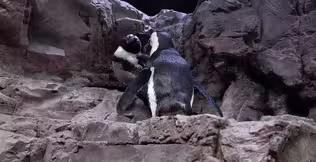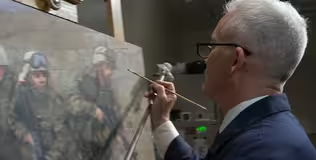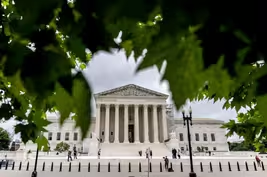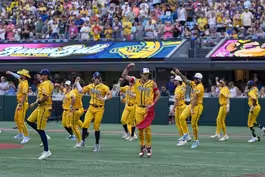
The long-term risks as extreme heat becomes a new normal
Clip: 7/4/2025 | 8m 11sVideo has Closed Captions
The long-term health risks as extreme heat becomes a new normal
Extreme heat is becoming a dangerous new normal that brings with it a number of health risks. From severe burns to accelerated aging, the effects of long periods of high temperatures on the human body are getting more attention in this time of rising climate change. Stephanie Sy reports from Phoenix, the epicenter of extreme heat in the United States, for our series, Tipping Point.
Problems playing video? | Closed Captioning Feedback
Problems playing video? | Closed Captioning Feedback
Major corporate funding for the PBS News Hour is provided by BDO, BNSF, Consumer Cellular, American Cruise Lines, and Raymond James. Funding for the PBS NewsHour Weekend is provided by...

The long-term risks as extreme heat becomes a new normal
Clip: 7/4/2025 | 8m 11sVideo has Closed Captions
Extreme heat is becoming a dangerous new normal that brings with it a number of health risks. From severe burns to accelerated aging, the effects of long periods of high temperatures on the human body are getting more attention in this time of rising climate change. Stephanie Sy reports from Phoenix, the epicenter of extreme heat in the United States, for our series, Tipping Point.
Problems playing video? | Closed Captioning Feedback
How to Watch PBS News Hour
PBS News Hour is available to stream on pbs.org and the free PBS App, available on iPhone, Apple TV, Android TV, Android smartphones, Amazon Fire TV, Amazon Fire Tablet, Roku, Samsung Smart TV, and Vizio.
Providing Support for PBS.org
Learn Moreabout PBS online sponsorshipJOHN YANG: Extreme heat is becoming a dangerous new normal.
Last week, it affected much of the United States.
This week, it's hitting Europe.
The heat brings with it a number of health risks.
From severe burns to accelerated aging, the effects of long periods of high temperatures on the human body are getting more attention in this time of rising climate change.
Stephanie Sy reports from Phoenix, the epicenter of extreme heat in the United States, for our series Tipping Point.
STEPHANIE SY: Summer's off to a sweltering start.
From New York to Chicago, triple-digit temperatures are behind heat illnesses, cancellations of sporting events and strained power grids and outages.
But nowhere is the heat more dangerous than in Maricopa County, Arizona, which, every summer, records hundreds of heat-related deaths and an untold number of heat-related burns.
ROBERT WOOLLEY, Phoenix Resident: I was checking the pool.
It was July 3, the hottest day of the year at that time.
It was about 116 degrees.
STEPHANIE SY: Phoenix resident Robert Woolley is 72.
The retired teacher and former Navy aviator was walking around his pool two summers ago when he tripped and fell.
ROBERT WOOLLEY: I put my hand down to catch myself and I was startled by how hot and sharp the rocks were.And instinctively I picked my hand up and I went all the way down to the ground and I actually hit my head on the ground.
And I tried to push myself back up.
And I got partway up.
And I tried that several more times, and I just could not get back up.
And each time I tried, my hands hurt worse and worse and worse.
And I looked at my hands and the skin had peeled off my hands, and it looked like raw hamburger underneath.
STEPHANIE SY: He eventually made it to the back door, where his wife could hear him.
When he arrived at Valleywise Hospital, he had third-degree burns on 20 percent of his body.
ROBERT WOOLLEY: When you're burned, you continue to burn, and they change your bandages daily.
And so when they unwrap you, it's like being skinned alive.
STEPHANIE SY: And yet Woolley is one of the luckier burn patients, says Dr. Kevin Foster, the director of the Arizona Burn Center at Valleywise.
DR. KEVIN FOSTER, Director, Arizona Burn Center: For the most part, we're capable of saving just about anybody with a burn.
However, the really difficult thing in the summertime is when heatstroke is also a problem, because high temperatures affect every system of the body, the neurologic system, the cardiovascular system, the G.I.
tract.
And that really is the determining factor of how these patients are going to do is, how bad is the heatstroke and how bad of the other systems have the body been injured?
STEPHANIE SY: The Burn Center is at its busiest during Phoenix's increasingly brutal summers.
DR. KEVIN FOSTER: As we urbanize and we have more concrete and more areas that absorb heat, that just makes the problem even worse, and you have more surfaces to get burned on.
Sidewalks, concrete, asphalt, paved surfaces rocks, those surfaces can get up to 170 or even 180 degrees, which is just a little bit below the boiling point of water.
So those are really, really hot surfaces.
It only takes a fraction of a second to get a deep burn when exposed to that.
STEPHANIE SY: While heat-related illness and injury can hit anyone in these extreme summer months, people experiencing homelessness and substance users are at particularly high risk, accounting for a disproportionate number of heat-related deaths in recent years.
WOMAN: Morning.
Circle the City.
Would you like some water?
STEPHANIE SY: Perla Puebla is the associate medical director of street medicine at Circle the City, an organization that provides medical treatment to the unhoused population in Maricopa County.
PERLA PUEBLA, Associate Medical Director, Circle the City: We have to go from wellness to death prevention in the summer.
STEPHANIE SY: She and her team go out daily offering medical care to people living on the streets.
The summers are also a busy time for them.
I PERLA PUEBLA: have seen severe dehydration, heat exhaustion.
I'm talking about the patients are actively sweating, they're dizzy, they're not feeling well, but they still don't want to go to the emergency room for many reasons.
It could be that they don't want to leave their pet.
They're no longer able to be hydrated with oral hydration and we have to provide I.V.
hydration, so intravenous hydration, to help them out.
STEPHANIE SY: Preventative measures like I.V.
hydration for patients who don't want to go to the emergency room may have contributed to the number of heat-related deaths ticking down last summer.
There were still more than 600 such deaths in the county.
BRANDELYN VALENCIA, Phoenix Resident: The hardest part is staying cool.
There's not a lot - - Arizona don't have a lot of trees, and they -- with being out on the street, they kick you out from everywhere.
STEPHANIE SY: Forty-three-year-old Brandelyn Valencia has been unhoused off and on over the last couple of years.
She had a checkup with Puebla and her colleagues in south Phoenix.
BRANDELYN VALENCIA: There's a lot of people with heat exhaustion, and I have seen a few people get heatstroke.
And they just -- thing is, it's that bad here.
It's that bad.
So it's not the best place to be out here on the street, but something happens.
And so they should just get the resources they can get and take - - use them, so they're not in this situation.
DR. REBECCA MORAN, Circle the City: The number of days with high levels of heat are lasting longer in Phoenix, and that is a problem for the unhoused population, because there is a period of time where they can get no relief at night because it does not get under 90 degrees at night for a prolonged period of time.
STEPHANIE SY: Dr. Rebecca Moran is the medical director of the Family Health Centers at circle the city and treats unhoused patients.
DR. REBECCA MORAN: Chronic medical conditions that normally don't change at all for somebody who's housed will change a lot for somebody who is unhoused because the heat interacts with the medicines.
The heat interacts with the underlying medical issue.
STEPHANIE SY: Meanwhile, new research from the University of Southern California suggests that greater exposure to extreme heat accelerates biological aging in older adults, raising new concerns about how climate change and particularly heat waves impact long-term health.
EUN YOUNG CHOI, University of Southern California: The effects of extreme heat might not show up right away as a diagnosable health condition, but they could be taking a silent toll at the cellular and the molecular level.
And, over time, this could accumulate and eventually lead to disability or disease.
STEPHANIE SY: Eun Young Choi is one of the study's co-authors.
In the study sample, people living in extreme heat experienced 14 months of additional biological aging compared to peers living in cooler areas.
EUN YOUNG CHOI: This effect was actually comparable to the fact that we could capture for the smoking, heavy smoking and drinking, which are two well-established risk factor for aging and disease.
STEPHANIE SY: Whether hidden or visible, heat's effects on health can be life-changing.
For Robert Woolley, it's been a long two years.
After an extended stay in the hospital and undergoing five surgeries and rehab, he's still not the same.
How has this incident changed your outlook on your life?
ROBERT WOOLLEY: I don't take things as granted as I used to.
I'm grateful for every day I'm alive.
STEPHANIE SY: And while the astronomer gazes at the sun through one of his many telescopes, he now sees its power in a new light.
For the "PBS News Hour," I'm Stephanie Sy in Phoenix.
Aquarium creates senior sanctuary for aging penguins
Video has Closed Captions
Clip: 7/4/2025 | 5m 54s | Aquarium creates senior sanctuary for aging penguins (5m 54s)
Brooks and Capehart on Trump's total control over Washington
Video has Closed Captions
Clip: 7/4/2025 | 12m 7s | Brooks and Capehart on Trump's total control over Washington (12m 7s)
Marine Corps art exhibit honors triumphs and sacrifice
Video has Closed Captions
Clip: 7/4/2025 | 6m 48s | Marine Corps art exhibit marking 250 years honors its triumphs and sacrifice (6m 48s)
News Wrap: Trump signs One Big, Beautiful Bill Act into law
Video has Closed Captions
Clip: 7/4/2025 | 5m 39s | News Wrap: Trump signs his One Big, Beautiful Bill Act into law (5m 39s)
Supreme Court rulings could have far-reaching consequences
Video has Closed Captions
Clip: 7/4/2025 | 7m 45s | A look at rulings from the Supreme Court term that could have far-reaching consequences (7m 45s)
Why fans are going bananas for Banana Ball
Video has Closed Captions
Clip: 7/4/2025 | 4m 58s | Why fans are going bananas for Banana Ball (4m 58s)
Providing Support for PBS.org
Learn Moreabout PBS online sponsorshipSupport for PBS provided by:
Major corporate funding for the PBS News Hour is provided by BDO, BNSF, Consumer Cellular, American Cruise Lines, and Raymond James. Funding for the PBS NewsHour Weekend is provided by...

















